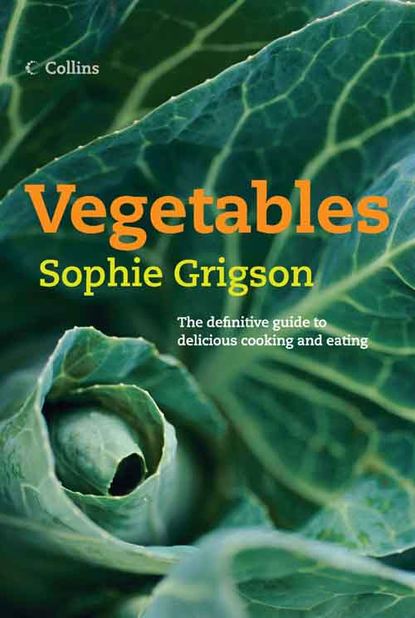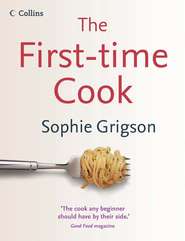По всем вопросам обращайтесь на: info@litportal.ru
(©) 2003-2024.
✖
Vegetables
Настройки чтения
Размер шрифта
Высота строк
Поля
Rocket (#litres_trial_promo)
Sorrel (#litres_trial_promo)
Watercress and Land cress (#litres_trial_promo)
Index (#litres_trial_promo)
Copyright (#litres_trial_promo)
About the Publisher (#litres_trial_promo)
Introduction (#ulink_f815c884-ffe0-5cc8-9544-ce2c9647a429)
I have no choice but to make this introduction relatively short. I’ve used up my space allowance several times over already, and the book has grown royally in length since its original inception. The trouble with writing about vegetables is that there are just so many, so much to say about each one, so many enticing ways to prepare them. This is also the joy of writing about them and more importantly of cooking and eating them.
When I compiled my original list of vegetables that I wanted to include in this book, I decided to concentrate on those that could be bought relatively easily in this country, with just a handful of exceptional rarities (such as chervil root or wild asparagus) thrown in for good measure. The original 60 vegetables have increased to over 70, ranging from the familiarity of the carrot or potato, to the more unexpected taste of oca or jicama. And still I have not shoehorned them all into these pages. Devotees of Chinese arrowheads or waterchestnuts, Indian tindoori or drumsticks or bitter gourds will be disappointed. My daughter complained that there were no recipes for palm hearts, and remains barely mollified by my excuse that I’ve only once bought them fresh, in Spain, and canned vegetables have no place on these pages.
Vegetables have long been something of a passion of mine. This is my second book on vegetables, coming over a decade after the first. I’m still learning about them, coming across new ones, delighting in new and old ways of cooking homely vegetables. I remain fascinated by their differences, their similarities, the way they take starring role, or blend comfortably into the chorus, the way they contrast, the way they add subtlety, the wonderful colours, the rich earthy tones, the sweetness and the textures, the forms, the connection with the land we live in, or with the magic of foreign worlds. I like the notion that the onion is virtually ubiquitous, that other cooks all over the world chop them and fry them just as I do, I love the exoticness of oca, so strange and new in Europe, but as old as the hills of the Andes where they are used without a second thought. Even familiar territory harbours magic discoveries – like the white sprouting broccoli of Leicestershire, or the dramatic purple carrots of Mallorca.
To make the book easier to use (and write) I’ve grouped vegetables together with the cook in mind. This may occasionally make botanists blench, and from them I beg indulgence. To me it makes more sense to slot beansprouts alongside asparagus and cardoons in the ‘shoots and stems’ section, than to keep them with beans and peas. Globe artichokes caused endless arguments, but in the end we kept them next to cardoons to which they are so closely related, even though no-one could ever argue that they are either shoot or stem.
One repetitive refrain runs through the following pages. With almost all vegetables, freshness makes a marked difference in flavour. With some it is more apparent than others. Newly picked spring greens are sensational, for instance, as are peas eaten straight from the pod out in the vegetable garden or allotment where they are grown. These are the kind of simple pleasures we should all have access to. Unfortunately so many of the vegetables sold in our shops have been held in storage for too long, or have been flown so far, that they have lost their brand new sparkle. They will still be in notionally good condition, but no longer in their prime.
This is why I like to buy locally grown vegetables when I can. If they are organic, so much the better. I’m no puritan – I eat cherry tomatoes in the middle of winter from time to time because I can’t bear the thought of going totally without fresh tomatoes for nine months of the year. I regularly forget which day of the month my local farmers’ markets fall on, but when I do get it right, both I and the environment around me reap the benefits. The more we support our local producers, the more opportunities there will be to buy locally grown crops and the more choice we will have.
Above all, however, the message of this book is to make the most of the incredible richness of the vegetable world. This is no health manual, but we all know that vegetables are good for us and we should be eating more of them. It’s not difficult if you give them a chance. Buy widely; choose wisely; cook exuberantly.
Sophie Grigson
Author’s acknowledgements (#ulink_80629f16-937c-51a4-a793-8e0e6934eae2)
My initial encounters with vegetables were, without exception, positive, thanks to my mother, the late Jane Grigson, who cooked them with care and love. I have her to thank for making vegetable-eating a pleasure right from the start, and for encouraging me to experiment with both familiar and new vegetables in later years. More recently, the regular weekly box of vegetables from Riverford Organics has shown me what an extraordinary difference genuine freshness makes to even the most pedestrian vegetables.
I would also like to acknowledge the debt I owe to so many of my friends, who have put up with me moaning about how long it has taken to pen this book, and above all to my editor, Denise Bates, and all of her team at HarperCollins, for their extraordinary patience and forbearance. The wonderful Susan Fleming has fitted copy-editing around the piecemeal delivery of the various sections of the book without a murmur of annoyance, at least in my hearing.
Once again I have been lucky enough to work with William Shaw, one of my favourite photographers (despite his appalling jokes), backed up by a wizard team consisting of the blessed Sam Squire on food and the long-suffering Rosie Dearden on styling – a real diamond, even though she doesn’t like cheese. Weird.
A big thank you to Zoltan and the cheery gang that run the coffee machine at Esporta in Oxford, which is where I retreat to write in relative peace. Annabel Hartog and Leslie Ball have helped me test recipes at home, while Sarah and Jennine have kept house, children and admin running smoothly. Last, but by no means least, a big thank you to the two most important people in my life, Florrie and Sid, who make me laugh, shout, get up in the morning, listen to Radio 1, and question almost every assumption I’ve ever made. They are also pretty good at eating vegetables. What more could a mother hope for?
Publisher’s acknowledgements
Thank you to North Aston Organics for their help with photography of vegetables, and The Conran Shop and Harrods for the loan of props.
Cook’s notes
There is one important element of vegetable preparation that I have omitted from the individual entries for fear of tedious repetition: unless they are to be peeled, all vegetables should be rinsed before use. Beautiful earthy potatoes and other roots will obviously need to be scrubbed as well, so a vegetable brush is an essential piece of equipment. A nail brush fits the purpose well enough, but make sure that everyone in your house knows and respects the fact that it is only to be used for vegetables, and not to scrub engine oil or paint off soiled hands.
In most instances, precise measuring of ingredients is not absolutely necessary. Take vegetable quantities as rough guidelines. Unless you are making something like the carrot cake on page 28 or the potato cakes on page 73, a little more or a little less will not ruin a dish. There is no point wasting a quarter of a potato, when following a recipe for mash, for instance.
On the whole, it makes sense to stick with either imperial or metric measurements. It makes life simpler, if nothing else. I often suggest using handfuls of this or that. Some people find this frustratingly vague, but it allows whoever is using the recipe to make their own decisions about the final strength of flavours in a dish. Ingredients, particularly herbs and vegetables, vary greatly from one batch to another, from one season to another. As cooks, we have to take this in our stride, adding a little bit more here, a little bit less there in order to compensate for fluctuations in flavour.
Unless otherwise specified, eggs are always free range and always large. Spoon measurements are rounded. I use a standard 15 ml tablespoon, 10ml dessertspoon and 5ml teaspoon. Recipes that include olive oil will taste better if made with extra virgin olive oil. Herbs are all fresh, with the exception of bay leaves (good fresh or dried) and dried oregano (use the fabulous Greek rigani, dried wild oregano, if you can get it), which is more exciting than fresh. Pepper and nutmeg should always be freshly ground to maximise spicy impact.
Finally, remember that suggested cooking times are not absolutes. Every oven has its own individual quirks, and settings vary. Similarly the width and make-up of saucepans will affect cooking times. So, check foods regularly as they cook, and if they look done, smell done, taste done, they probably are.
Roots (#ulink_8c50e028-5981-5602-8e6d-75c48aa82634)
Beetroot (#ulink_5db52be5-4565-5237-969e-03697c02fde5)
I’d like to serenade the beetroot. Thank your lucky stars then that this is a book, and you can’t hear me try. Tunefulness was never my strong point. The fact is, though, that beetroot is a miraculous vegetable. Despite extraordinary maltreatment (what else would you call boiling the poor things in vats of malt vinegar?) the beetroot has re-emerged in recent years as something of a star. It features on the menus of the most elevated of restaurants, and it appears regularly in the smartest recipe books, regaining its rightful reputation as a truly delicious, unique vegetable. What other vegetable can offer the combination of full sweet, earthy flavour together with the rich purple-red of a classic beetroot?
If the foregoing leaves you bewildered, it may just be that you have never tasted beetroot at its finest. In other words, home-roast beetroot, cooked slowly to preserve its true flavour. Sure, you can save time and buy it ready-cooked in neat little vacuum packs, but it will have already lost so much to the processing that it is hardly worth the bother. Sure, you can save time and boil your beets in a large pan of water, but again, so much flavour flows out that you end up with a dumbed-down version.
The classic dark purple, staining beetroot is not the only form of the vegetable in existence. The colourways can vary from the palest white spattered with rose, to the summery hue of golden beetroot. Although both occasionally wander on to the shelves of smart greengrocers, or even the better supermarkets, they are hardly common fare. You are more likely to come across them at a farmers’ market. Or, of course, you could grow them yourself and enjoy them pulled straight from the ground, golf-ball sized. Is the taste of these golden beets different? A little, I think, though not radical enough to make headline news. The colour is the main attraction plus the fact that the juice doesn’t stain clothing to anything like the same extent.
Practicalities
BUYING
If possible, buy beetroot by the bunch, complete with leaves. The leaves are the best indicator of freshness. When they are crisply firm, squeaky in their perfection, you know that the beetroot has come out of the ground recently. As it happens, these telltale leaves are also rather good to eat. Like some earthily rich form of spinach, they can be stir-fried or blanched and served up with a knob of butter melting over them, or Italian-style with a slick of olive oil and plentiful freshly squeezed lemon juice. Or, chop fine and use in a stuffing for ravioli. They’re good, too, treated like kale, blanched and fried up with crisp, salty bacon.
As for the beets themselves, only buy them if they are firm with taut skins. Any suggestion of softness or wrinkles tells you that they are older than they should be. It’s one thing for you to keep them hanging around in your vegetable drawer for a few days, but it’s not on for the retailer to palm off old stock on you. It is rare to have much option over size, but if you do, choose medium-sized ones over large, for a gentler, but never wimpy, taste. Snap up teensy beetroots whenever you get the chance, for these are the choicest of all, with a marvellous sweetness and silky-smooth texture when cooked.
COOKING
Although it is not the only way to cook beetroot, by far the best general method is to roast them, guarding all their juiciness and flavour. For most purposes, the process is as follows: wash the beetroots well (but don’t scrub brutally, which will rupture the skin) and trim off the leaves, leaving about 2 cm (
/
in) of stalk in place to minimise bleeding. Do not trim off the root. Wrap each beetroot individually in foil, place in a roasting tin or ovenproof dish and slide into a preheated oven. For the finest results the temperature should be fairly low – say around 150°C/300°F/Gas 2. You should allow 2–3 hours for the beetroots to cook. They will still turn out well at a higher temperature if you want to speed matters up a little, or have something else cooking in the oven – anything up to 200°C/400°F/Gas 6 will do nicely. To test, unwrap one of the larger beetroot and scrape gently at the skin near the root. When it comes away easily, the beetroots are done. Take them out and cool slightly, then unwrap and skin each one.
I don’t boil beetroot, although many people would cook it no other way. Boiling introduces a wateriness that diminishes the joy of good beetroot. If you want to speed up the cooking process, then I would suggest that you think of peeling and cutting up raw beetroot into smaller pieces (say 2–3 cm/1 in cubes), then roasting in a hot oven, tossed with a little olive oil, salt, pepper and some whole garlic cloves and sprigs of thyme, or a good sprinkling of fennel seeds or dill seeds. As with most roast vegetables, they’ll need some 40–60 minutes in the oven – cook uncovered, turning occasionally and adding a little water or orange juice if you think they look worryingly dry. It may be necessary to cover the dish with foil towards the end of the cooking time if the chunks of beetroot are still not quite tender. Sautéed beetroot is also surprisingly delicious – make the cubes a little smaller, say 1–1.5cm (
/
in) across, and sauté them in olive oil or sunflower oil until tender.
PARTNERS
Despite, or perhaps even because of, its distinctive presence, beetroot has an affinity with a remarkable number of other ingredients. In eastern Europe, where it is used most famously to create borscht – beetroot soup in several different forms – beetroot is often combined with aniseed flavours (fennel seed, aniseed, dill and so on) and with soured cream. Try serving cubes of hot cooked beetroot tossed with fresh dill and butter, or fry it briefly with cubes of eating apple and bruised fennel seeds, then serve topped with a spoonful of soured cream (or stir crème fraîche, not soured cream, which will split, into the pan to make a light sauce). Cooked beetroot (puréed or finely diced) is also a brilliant addition to mashed potato, turning it a startling bright pink, which will wow children as much as it amuses parents.
It is, perhaps, in salads that beetroot scores most noticeably, but not the kind of horrorscape of bleeding beetroot lying supine and flabby against miserably limp lettuce leaves, stained gorily with streaks of dark red. No, a good beetroot salad needs a little care in its creation, so that the colour works for it rather than against. Dress the beetroot with vinaigrette while still hot, so that it absorbs some of the tastes, then set aside until ready to plate up with other ingredients. In salads, classic beetroot partners are orange, apple, potato, celery and walnuts in particular. Salty additions also work well – crisp bacon, black olives and anchovy, for instance. On the whole I think it best not to muddle the beetroot with too many partners. The idea should be to highlight its delights, not to mask.
Raw beetroot makes a handsome addition to salads in moderation. The most famous example of this is the French salade nantaise: frisée or blanched dandelion leaves and/or tender lamb’s lettuce (a.k.a. mâche or corn salad), tossed with coarsely grated shreds of raw beetroot and a warm dressing made with bacon frizzled in its own fat and a touch of oil, garlic and red wine vinegar. A gorgeous treat of a salad. I also use raw beetroot with sweet cos lettuce and grapefruit tossed in an animated oriental-toned dressing (see page 381), to totally different effect.
Australian market beetroot dip
The main markets in both Melbourne and Adelaide are thrilling. Bustling and vibrant, they offer superb produce, ranging from fruit and veg, through cheeses, wines, meats and breads, not forgetting dazzling deli stands where you can choose from impressive ranges of freshly made pestos and dips. The brilliant pink of one dip made us pause, then inspired a picnic built around it. The natural sweetness of beetroot balanced by a touch of sourness from the cream and lemon and a waft of spice is very good – eat it with warm pitta bread or batons of cucumber, pepper, carrot and celery.







